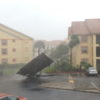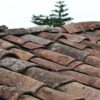Something Exciting Yet to Post!
empowerment through education
Something Exciting Yet to Post! Read More »
homeowner’s tips
empowerment through education
Something Exciting Yet to Post! Read More »
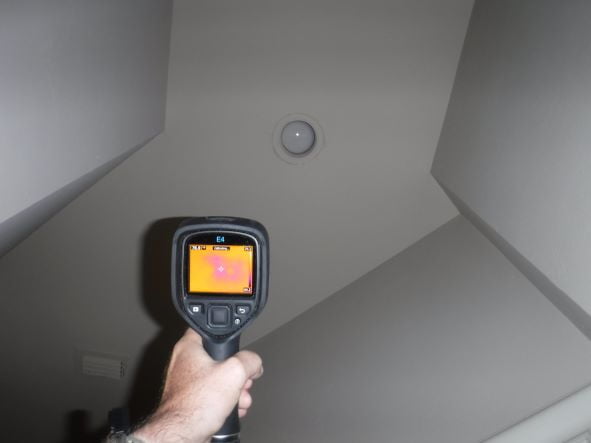
A mold assessor, of course!
As long as we have inhabited structures, we have been living with mold. So what happens when you realize that you really may have a mold problem?
One place to start is with a mold assessor. Mold assessment and testing is a combination of science and creative judgment on the part of the mold assessor. There are no firm industry standards that designate one single “right” way to assess and test a structure, which makes it imperative to select an experienced, reputable mold assessor.
Be aware that there is a difference between a mold assessor and a mold inspector. The two main differences are as follows: 1) a mold assessor has undergone a higher level of training than a mold inspector, and 2) a mold assessor is the architect of the project whereas a mold inspector performs mold testing but without the in-depth assessment and project management skill-set.
The mold assessor is essentially the architect of the project, a common industry phrase referencing their pre- and post-project responsibilities. Due to this managerial role of the mold assessor, selecting a qualified and experienced assessor is the first step to take.
Performs a visual assessment of both the structure and the property under and around the structure. This visual assessment is subjective, so experience is a critical component that enables the assessor to make the correct determination based on the visual inspection.
Identifies the source of water or moisture, when possible. Keep in mind that mold assessors do not perform invasive investigations, such as removing walls or shower tiles, so they may not be able to visually see the cause of moisture to identify it. Conversely, since mold re-mediators do perform invasive investigations by removing structural building materials, it is legally their responsibility to locate the moisture source and make sure it is fixed before closing up and putting the investigated area back together.
Designs and implements testing protocol according to industry standards. Ideally, a combination of testing methods should be used to give the broadest picture of what is going on in the structure.
Interprets objective test results in the context of the site visit. Reports findings in a written mold report.
When applicable, outlines a generalized mold remediation protocol that includes the specific criteria that must be met for the project to pass Post Remediation Verification (PRV).
Confers with the mold re-mediator on the remediation protocol. Please note that it is the responsibility of the re mediator to notify the mold assessor if the scope of the plan needs to be altered based on the additional information gained during the invasive investigation.
Confirms completed execution of remediation protocol by mold re mediator.
Performs PRV testing to determine that PRV criteria have been met. Keep in mind that the initial mold assessor can perform clearance testing, or another company can be brought in to do it.
For more information visit Florida Health
Mold Problem? Where Do You Start? Read More »

don’t waive home inspectionTrade Secrets Home inspections; naples florida home inspections
It seems like right now there’s definitely a rush to move to Florida. While it seems that the market is hot everywhere, we are definitely seeing the effects of it in our area. There’s a really high demand for homes, but there’s a shortage of homes listed. But, there’s a huge supply of people willing to pay just about anything, including over-asking price, and it’s creating some really crazy things happening in the market.
People are calling to request inspections in a 3 to 5 day inspection period. And that’s in the cases that they’re not waiving the inspection completely. That’s what’s really concerning: people from other parts of the country moving down to Florida. These people are not familiar with the environment and conditions here, so to just step into a high risk, huge investment seems like such a peril.
If you’re a Realtor or a buyer there are some ideas and options on what you can do in this competitive market. You may not be aware of some of the risks involved to decline the property inspection. Today properties are selling $10, sometimes $100’s of $1000s of dollars over appraisal value. People are willing to spend that kind of money, and that’s fine. But there’s so much competition that the sellers are being put in this power position, where they get to say, “I have so many people offering me to take this right now, I can make some demands that otherwise wouldn’t generally happen.”
If you don’t have the time or you’re not in a position to do the full due diligence inspections, there are some options. There is what is called an “informational only inspection” or a “walk through inspection”. Essentially, you bring your home inspector on your initial walk through of the open house or property, and instead of doing a written inspection, the inspector walks through it with you.
One of the other options we tell people is to put in your offer. If you’re going to offer what is generally more than asking, put in a bonus offer for allowing the inspection. Many times that the report comes back with at least $2,500 dollars worth of findings. Even if you’re not going to get that money credited to you, or accounted for you in the offer, you just need to know what it is you’re purchasing. A few dollars spent today could save you $50,000 tomorrow.
There are four fundamental insurance forms that document the major systems, to include HVAC, roof, electric and plumbing. Roofs are now becoming harder and harder to insure, and it’s not that the roof has a problem- it’s that there are fewer insurance companies that want to take the risk to insure it. Even though a roof might be brand new!
If your roof is 15 years right now there’s almost no company out there willing to offer you a coverage policy on it. They’ll give you insurance on the house, but then limit the coverages, such as water intrusion, or they won’t cover the roof. In cases where cash buyers don’t need to meet the mortgage requirements, you still need to be aware that you are responsible if a new roof is needed. In your offer you should always make sure it is included that you have the right to void regardless of whether the customer is saying they’re selling the property as is. Everything is simply a negotiation. How much risk are you willing to take?
I met with some clients a couple of weeks ago who didn’t think they were going to do the inspection. Because I was able to fit them in the schedule within the shortened timeline, they decided on an inspection after all. Because this newly remodeled home looks beautiful, they weren’t convinced that it was worth spending the time or money.
This newly remodeled home had no outstanding issues other than some small repairs here and there; the workmanship was also fine. The one problem, however, is there are no permits on file.
Yes. The city really does get involved in these big construction projects that weren’t done correctly, or legally with permits. So from there the city will say you need to buy all the permits, and will most likely charge triple. And, the city will have to do all the inspections, which often means you have to take everything apart, because they want to do the rough-in inspections and that’s all buried behind the beautiful finishes. It would seem as if you were remodeling that house again.
Your best course of action in that case is to invest some time in finding out exactly what it is you’re purchasing. Before they blindly handed over $500,000 the clients decided to walk away from that property.
This happens every day. Let us be your advocate. Don’t let the pressure of the seller push you into something you aren’t prepared for! There are alternatives to a full home inspection!
Rick
Don’t Take the Risk! Read More »
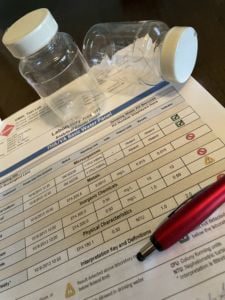
Where you get your drinking water from is important! Did you realize that aside from coming from the building materials inside your home, you may have Radon dissolved in your tap water?
One place where we are exposed to Radon is in the water, especially if you’re using well water. Radon is actually dissolved into the water and is released in a gas form. To some extent we do ingest it if it’s the water at a saturated level. We could be drinking the Radon in the water- but the problem is there hasn’t been any recorded data that points to ingesting Radon as being a problem, it’s it’s the gas, Radon that’s causing lung cancer, that’s the, that’s the real problem.
However, things like taking a hot shower allows the evaporation from the hot water, putting high levels of Radon in the air. There are ways, though, to mitigate the Radon in the water. Oftentimes, well systems in Florida use air aeration tanks to begin the process because of the sulfur content and odor in the water. And that’s a great way to help mitigate the Radon as well because it gives it time, and it’s literally aerating the water. So you’re literally taking the gas out of the water, which is exactly what we’re trying to do.
When we drink from our public water, it has already undergone processing through a water treatment plant. There the requirements of testing are held to a standard and is constantly monitored. In fact, water is a very touchy subject with the health department here in FL. The public is always allowed access to the testing results of the city water, We would only recommend testing city water if you’re concerned with particular problems of the building, like lead pipes or something that is very localized to a specific location.
If you’re doing FHA or VA loan, you will want to test all sorts of water. The VA very specifically require a water test for part of the loan package. There are several different water tests that we can perform for you. We don’t do the test, but we do the sampling and then provide it to the lab.
There are different ways and different tests out there. There’s a simple what we call the bacteria test. If you’re on a well we recommend that you have your well tested yearly: the water table is constantly changing down here and you can have bacteria move into your well. Generally if you’re on a well you also have a septic in your yard. Depending on how the water table is moving around, you could be bringing bacteria from your septic into your well. It’s a good idea to keep an eye on those things. That test in particular is not a big deal. As a homeowner, you can actually do it yourself. You can contact the Department of Health; go down to the water department and they will give you the equipment you need to take the sample. You bring it to them and they’ll test it for you for a fee. The test we do is basically the same.
We can also do it on site while we’re there inspecting; it’s a simple well test and it’s going to test for E coli and coliform bacteria. These are the bacteria that most commonly lead to intestinal problems.
There is a full panel test that is more of what’s called the FHA /VA test. That one gets sent to Orlando lab (there’s actually only a few labs in the whole country that do the full panel water test). That one that one is quite extensive, and the fee supports that. It does, however, include testing for leads and nitrates, nitrates turbidity, things of that nature.
Have more questions? Call me, I’d love to discuss!
Rick
239-537-1186
For more information and details on Radon:
Rick’s Podcasts
Radon
Radon In Your Drinking Water? Read More »

First, I want to talk about what Radon is. When we say the word Radon, what we’re referring to is a gas that’s actually produced by the disintegration of Uranium. Essentially it’s a radiation gas, and it’s pretty much found everywhere. It occurs naturally in the soil and the earth all over the place. It primarily comes out of rocks, essentially, because that’s where we’re going to find the uranium products. Depending on where we’re at geographically, it does matter.
There are places where it’s more prevalent than others and a lot of people think here in Florida that that it’s really not occurring in the soil. But that’s true only to some extent. We do find it in the soil to a degree, and there are pockets where it’s found more readily. But more importantly, the Radon source in our homes and buildings is coming from the building products that are being used. We’re using a lot of concrete products in our buildings here- block and slabs and stones; and all those things contain radiation products. Depending on where they were sourced from and where we’re putting in to the home, the levels will vary.
Radon levels vary greatly from location to location, so the only way to know what the levels are is to test. Radon is ubiquitous in its nature: it doesn’t have any taste or odor or color, so it’s very difficult to identify or even know if you’re subject to harmful levels.
Our government monitors it. There is currently a rating for Collier County and approximately 20% of the homes right now- or 20% of the land in Collier County- is rated at “above” the safe level of what is measured in picocuries per liter (pCi/L) of air. This standard measure is very small: it’s a trillionth per two radiation units per minute. The standard for the cutoff line is 4.0 pCi/L. Anywhere in that area is going to be a risk zone. To say that 3.9 is safe and 4.0 is not is kind of silly but that’s where we draw the line. At 4.0 they say you must put a mitigation system in to accommodate for it.
I have found that about one in five homes we test come up positive for it, requiring a mitigation. There’s no real rhyme or reason to it. I’ve seen it in multiple story condos, say a 10th floor unit, and the one unit will have it and the adjoining unit will not. It’s very dependent on pipe chases and materials used in in the unit. Things like granite counter tops can be very reactive; if we put a Radon testing unit in a home and we set it near a granite counter top it will come back positive every time. Placement of the devices is extremely important to ensure accurate results. That’s part of why state licensing is required to perform Radon testing; there are several environmental companies I work with that allow them to do the Radon testing.
For more details, the full Podcast episode, and the full transcript go to:
Radon: Exactly How Harmful Can it Be? Read More »
Polybutylene is a form of plastic resin that was used extensively in the manufacture of water supply piping from 1978 until 1995. Due to the low cost of the material and ease of installation, polybutylene piping systems were viewed as “the pipe of the future” and were used as a substitute for traditional copper piping. It is most commonly found in the “Sun Belt” (Florida) where residential construction was heavy through the 1980’s and early-to-mid 90’s, but it is also very common in the Mid Atlantic and Northwest Pacific states.
They were inexpensive and easy to install–but homeowners and plumbing professionals have discovered one serious flaw: Over time, the pipes undergo a process called dezincification.
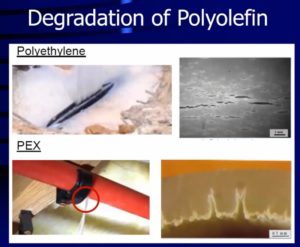
In general, polybutylene pipes make it very difficult to get covered by homeowners insurance. Most homeowners insurance companies view them as too liable to fail and cause damage.
Curious to see what your insurance quotes could look like? Our colleague, Paul Hursta, is a Risk Management Specialist and can provide you with insurance solutions to fit your needs.
Click here to view the results.
If you are considering a home with poly pipes, you must be aware of what is involved in replacing them. Consulting with a professional is your first line of defense.
Here’s why: Polybutylene pipes will eventually fail. They are vulnerable to what is called a dezincification process, whereby zinc leaches from brass…thereby creating a white powdery buildup on the inside of the fitting and weakening the brass fitting.
If you’re looking at buying a new home, your inspector will be able to tell you what type of pipes the home has, but if you want to see for yourself you can also look at the pipe directly.
Poly-what…? Can this really affect Homeowner’s Insurance Coverage? Read More »
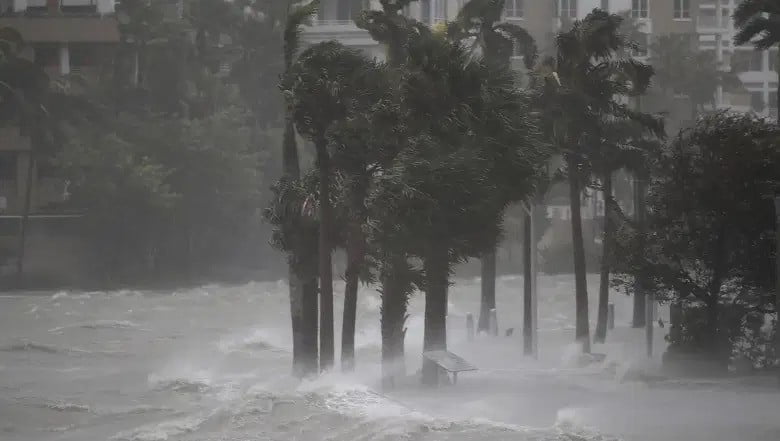
With the 2021 Hurricane Season fast approaching, now is the time to review your insurance coverage and make sure to purchase flood insurance if you have not already!
If you have a mortgage and your lender does not require flood insurance, you may have overlooked the importance of having a flood insurance policy.
For more information from FEMA click here to be directed to their flood insurance fact sheet..
For more local online storm resources, WINK News Hurricane Central is full of information!
If you’re in the market for an insurance company, or would simply like to compare rates, contact us- we’ll point you in the right direction!
239-537-1186
Now Is A Good Time To Review Your Insurance! Read More »

Keep you and your family safe during a severe storm with up to date information.
The FEMA mobile app features:
Click here to download app for Apple and Android
Conditions change fast during severe weather events. Ready.gov has detailed information on how to prep for every weather event. Get information on:How to determine your risk Create an emergency plan. Coping with power outages
All evacuation orders should be taken seriously, as they are put in place for your safety.
Check out the CDC’s tips for evacuating here. Fast takeaways:
Severe Weather Resources Read More »
With most of your focus on your family and home, you may not think much about your car during a hurricane. But, it may just be your key to safety if you need to evacuate. Don’t forget to speak to your agent, as well, with any concerns or questions you may have.
Make sure your car is ready and that you understand how to drive in severe conditions.
Know how to protect your boat if a hurricane or other severe weather event is approaching. These tips were developed with help from the U.S. Coast Guard and Federal Emergency Management Administration. Ultimately, the best way to protect your vessel is to remove it from the water, and all other measures are supplemental in the event this can’t be done.
With any of these scenarios, if you’re out of town, ask a friend or relative with access to your boat to help. Sure, you’ll “owe him,” but that favor could help prevent some very expensive damage.
Of course, the most important thing to remember is to protect yourself. Never put yourself in danger while trying to protect your boat.
Your RV can help you and your family evacuate an area, and serve as a cost-effective, temporary living space if your home isn’t livable due to storm damage.
Here are a few tips to make sure your RV is hurricane-ready.
Again, reach out to a local agent, or us. We can help answer your questions and direct you to a resource.
Stay Safe out there!
Rick
239-537-1186
Hurricane Season Is Around The Corner, Are Your Vehicles Ready Too? Read More »

Let the Internet be your guide. By no means is this list exhaustive, but hopefully it gets you pointed in the right direction. And, of course, there’s no shortage of helpful tips you can glean from the Internet. For example, Ready.gov is a great resource to mine for more proactive ways to be prepared. You can also reach out to your local insurance agent, or we can direct you to the right resources!
Stay Safe out there, and call with any questions!
Rick
239-537-1186
Hurricane Readiness, What To Do First? Read More »
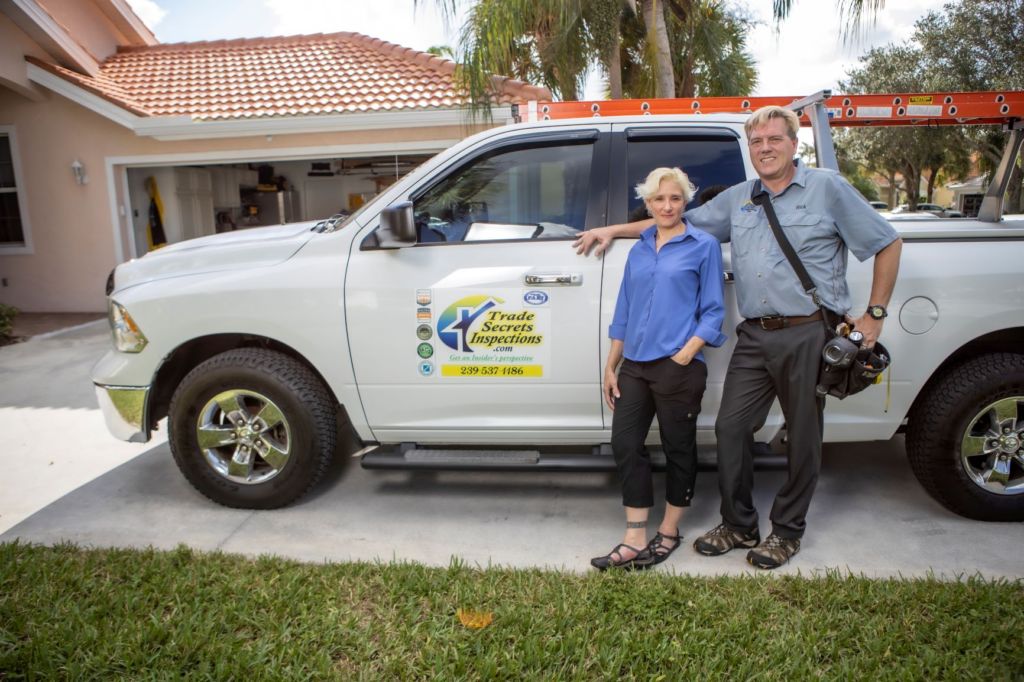
So your purchase is complete on your new dream home! What’s next? Below we have some tips and tricks that will help make your transition into home ownership a little easier. Prefer hands-on learning? We’ll come to you and teach you the ins and outs, what to look for, and provide you with a list of resources. We’re here to help!
You may have noticed during the purchasing process that there is a lot of paperwork involved in owning a home. Before you move into your new home, create a binder for important documents, such as mortgage and home insurance paperwork.
After your move in, use the same binder to store all of the guides and warranties for your new appliances. Store receipts for any home improvement and moving expenses here as well. You’ll want to hang on to these for your taxes. You can also start collecting contact information for reliable contractors in this binder.
One thing every homeowner should know: home improvement projects are expensive. Avoid completing unnecessary projects. Unless your new home is not livable, hold off on any major construction projects until you’ve lived in the home for at least six months.
Waiting a few months to make any huge changes will allow you to get a feel for your home and put your priorities in order. After a few months, you may learn that the floor plan doesn’t bother you as much as expected, but you’ve discovered you can’t live with the current bathroom configuration. Waiting will also give you time to save for the cost of any upcoming projects.
It is a good idea to complete small projects such as painting or removing carpet before moving into your new home.
Don’t work on multiple home projects at once. You may want to get all your improvements finished as soon as possible, but this isn’t the answer. Not only will you exhaust your finances, but you will also make your new home unlivable and add unnecessary stress to your everyday life.
One of the best homeowner maintenance tips is to detect minor problems before they become huge issues. After purchasing your home, take some time to learn about some of the common issues homes face, especially if you’ve purchased an older home or one that was unoccupied for a period of time. Being able to identify a potential problem early on could save you money later.
Learn to recognize:
If you can catch these issues early, you can prevent further damage to your home and save yourself a lot of headaches.
You never know when something is going to go wrong, or how much it is going to cost. A great homeowner tip is to start an emergency savings account as soon as possible.
The longer you live in your home, the more likely you are to experience a surprise plumbing, heating or roofing issue. Start saving early to take a little stress out of this typical homeowner experience.
Owning a home means paying your own utility bills. Pay attention to how your home is using energy and use the information to reduce your carbon footprint and save money. You’ll be surprised how small changes can affect your electric bill.
Homeowner tips and tricks for reducing your energy costs:
As many homeowners know, having bad neighbors can make your living situation less than pleasant. Work to be a good neighbor right away by introducing yourself and making friends as soon as you move in. Building a relationship with your neighbors will help you learn about your neighborhood, find reliable contractors and maybe even allow you to borrow tools when you need them.
Knowing your neighbors will also make it easier to address any issues that arise later, such as property line or noise concerns.
Picture this: You wake up in the middle of the night to find a busted pipe filling your basement with water. It takes you five minutes to locate your main water valve and two more minutes to turn it off. That’s seven additional minutes of water flowing into your basement.
It’s a good idea to locate this valve when you move in and learn how it works to save yourself time during an emergency. Learn how to shut off your power and gas lines while you’re at it.
Another homeowner tip is to turn off your main water valve whenever you leave on vacation. This will prevent flooding if something should go wrong when you are out of town.
This probably sounds obvious, but it is an often overlooked homeowner maintenance tip. When you move into your home, change your air filter right away. Mark the date on your calendar and change it every 90 days moving forward. Consider changing it every 60 days if you have pets or if you suffer from allergies.
Changing your air filter not only helps keep your air clean, but it also reduces dust in your home and extends the life of your furnace.
Now that you’re a homeowner, it’s time to get yourself a toolbox. From measuring for a new couch to hanging curtains and photographs, you’re going to need tools even if you’re not planning any big DIY projects.
Best tools for new homeowners:
Owning these tools will make following the rest of these new homeowner maintenance tips easier.
Tips and Tricks for The New Homeowner Read More »
Hi there friends this is Rick with Trade Secrets Inspections; we’re out in Mediterra today where Tropical Storm Eta is unleashing some rain and wind, where we’re going to do a full unit inspection. Generally some rain is necessary to determine exactly where leaks have formed, but the hurricane-like conditions are a bit over kill.
Roof Inspection during Eta Read More »
Let’s get your new roof replacement inspection, because a new roof inspection is what you need. Or maybe you need a new roof inspection in Island Walk, SW Florida.
Hi there Trade Secrets friends, just got down off the roof today over in North Naples here in the Island Walk community.
We just checked out a new roof that’s going in; you can never be too cautious. Keep that in mind you’re spending a lot of money on these things you definitely want to make sure that you’re not going to have problems.
I can help identify any issues before it’s too far into the installation! Give me a call at 239-537-1186, or for more information go to More Roof Inspection Information
Process of Roof Replacement Read More »
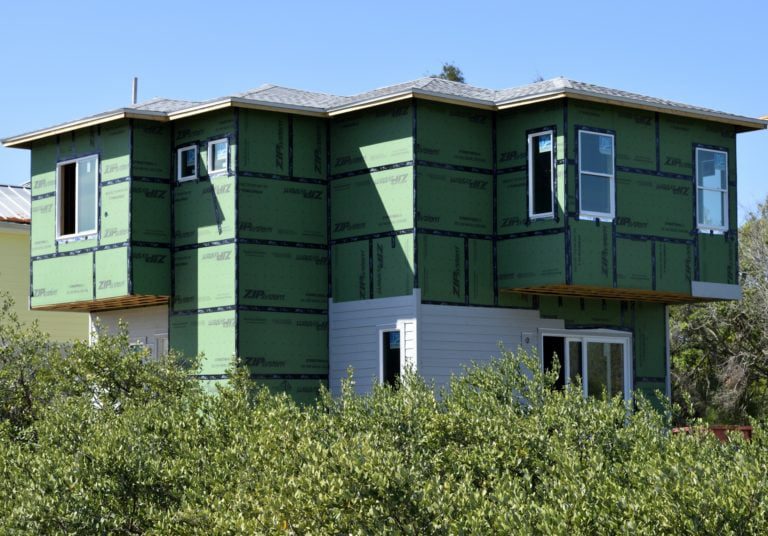
You’re probably thinking, “But it’s a brand new build, why would I need a home inspection?” Because it would seem that new homes should be relatively error-free, according to many inspectors, they often have underlying issues at work.
What could possibly be wrong, you ask?
Inspectors say they also often find incomplete projects. This could include insufficient insulation, half-installed handrails or fixtures, or missing pieces of hardware.
One common myth is that all construction defects are discovered through municipal building inspections. That is incorrect, not due to any shortcomings on the behalf of the inspectors, but the purpose, scope, time allotment and procedures for municipal inspections are not the same as for home inspections. Also keep in mind they are primarily looking at code compliance, not quality of workmanship.
While they can cite a builder for improper structural framing or for non compliant drain connections, a poorly fitted door or an uneven counter top are not included on their list of concerns.
Municipal inspectors rarely inspect an attic or a crawlspace. They come to the job site with a clipboard and a codebook, not with a ladder and overalls. Construction defects in such areas can escape detection. Municipal inspectors typically inspect a roof from the ground or possibly from the builder’s ladder. From these perspectives, defects can go undiscovered. Since final inspections are performed before the utilities are turned on, municipal inspectors cannot inspect appliances and fixtures. The lack of utilities also prevents the testing of plumbing fixtures such as sinks, showers, tubs, and dishwashers, and of gas fixtures such as furnaces, fireplaces and water heaters, which is part of the FABI Inspecting Standard. Without power, outlets can’t be tested for ground and polarity, nor can they test the performance of GFCI or AFCI safety breakers.
When buying a new construction home, you should not forego the benefits of a thorough home inspection.
Do I Need a Home Inspection for New Builds? Read More »



